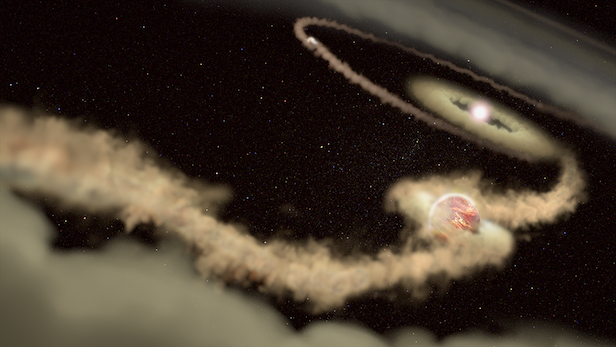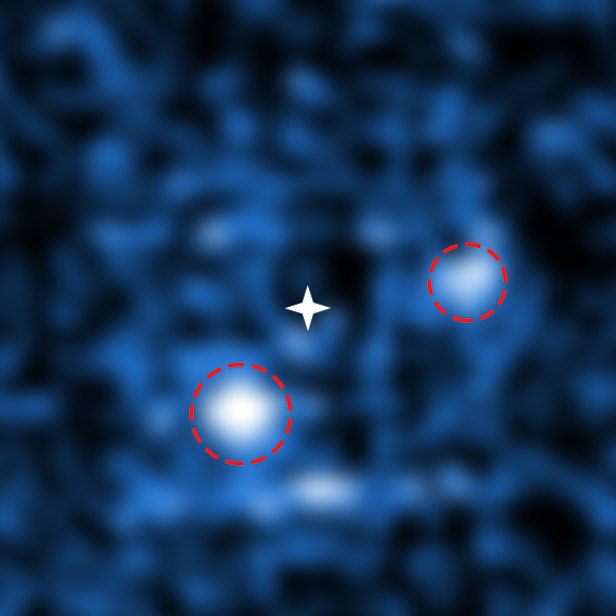Two young exoplanets have been seen clearing a path through its protoplanetary disk
The two exoplanets in the PDS 70 system are sweeping up material as they go to sizes up to 17 times that of Jupiter

This artist’s illustration shows two gas giant exoplanets orbiting the young star PDS 70. Image credit: J. Olmsted (STScI)
Astronomers have directly imaged two exoplanets that are gravitationally carving out a wide gap within a planet-forming disk surrounding a young star. While over a dozen exoplanets have been directly imaged, this is only the second multi-planet system to be photographed. (The first was a four-planet system orbiting the star HR 8799.) Unlike HR 8799, though, the planets in this system are still growing by accreting material from the disk.
“This is the first unambiguous detection of a two-planet system carving a disk gap,” says Julien Girard of the Space Telescope Science Institute in Baltimore, Maryland, United States.
The host star, known as PDS 70, is located about 370 light years from Earth. The young six-million-year-old star is slightly smaller and less massive than our Sun, and is still accreting gas. It is surrounded by a disk of gas and dust that has a large gap extending from about three to 6.1 billion kilometres(1.9 to 3.8 billion miles).
PDS 70 b, the innermost known planet, is located within the disk gap at a distance of about 3.2 billion kilometres (two billion miles) from its star, similar to the orbit of Uranus in our Solar System. The team estimates that it weighs anywhere from four to 17 times as much as Jupiter. It was first detected in 2018.
PDS 70 c, the newly discovered planet, is located near the outer edge of the disk gap at about 5.3 billion kilometres (3.3 billion miles) from the star, similar to Neptune’s distance from our Sun. It is less massive than planet b, weighing between one and 10 times as much as Jupiter. The two planetary orbits are near a 2-to-1 resonance, meaning that the inner planet circles the star twice in the time it takes the outer planet to go around once.

PDS 70 is only the second multi-planet system to be directly imaged. Through a combination of adaptive optics and data processing, astronomers were able to cancel out the light from the central star (marked by a white star) to reveal two orbiting exoplanets – PDS 70 b (lower left) and PDS 70 c (upper right). Image credit: ESO/S. Haffert (Leiden Observatory)
The discovery of these two worlds is significant because it provides direct evidence that forming planets can sweep enough material out of a protoplanetary disk to create an observable gap.
“With facilities like ALMA, Hubble, or large ground-based optical telescopes with adaptive optics we see disks with rings and gaps all over. The open question has been, are there planets there? In this case, the answer is yes,” explains Girard.
The team detected PDS 70 c from the ground, using the MUSE spectrograph on the European Southern Observatory’s Very Large Telescope (VLT). Their new technique relied on the combination of the high spatial resolution provided by the eight-metre (26-foot) telescope equipped with four lasers and the instrument’s medium spectral resolution that allows it to “lock onto” light emitted by hydrogen, which is a sign of gas accretion.
“This new observing mode was developed to study galaxies and star clusters at higher spatial resolution. But this new mode also makes it suitable for exoplanet imaging, which was not the original science driver for the MUSE instrument,” says Sebastiaan Haffert of Leiden Observatory, lead author on the paper. “We were very surprised when we found the second planet.”
In the future, NASA’s James Webb Space Telescope may be able to study this system and other planet nurseries using a similar spectral technique to narrow in on various wavelengths of light from hydrogen. This would allow scientists to measure the temperature and density of gas within the disk, which would help our understanding of the growth of gas giant planets. The system might also be targeted by the WFIRST mission, which will carry a high-performance coronagraph technology demonstration that can block out the star’s light to reveal fainter light from the surrounding disk and companion planets.
Keep up to date with the latest news in All About Space – available every month for just £4.99. Alternatively you can subscribe here for a fraction of the price!




